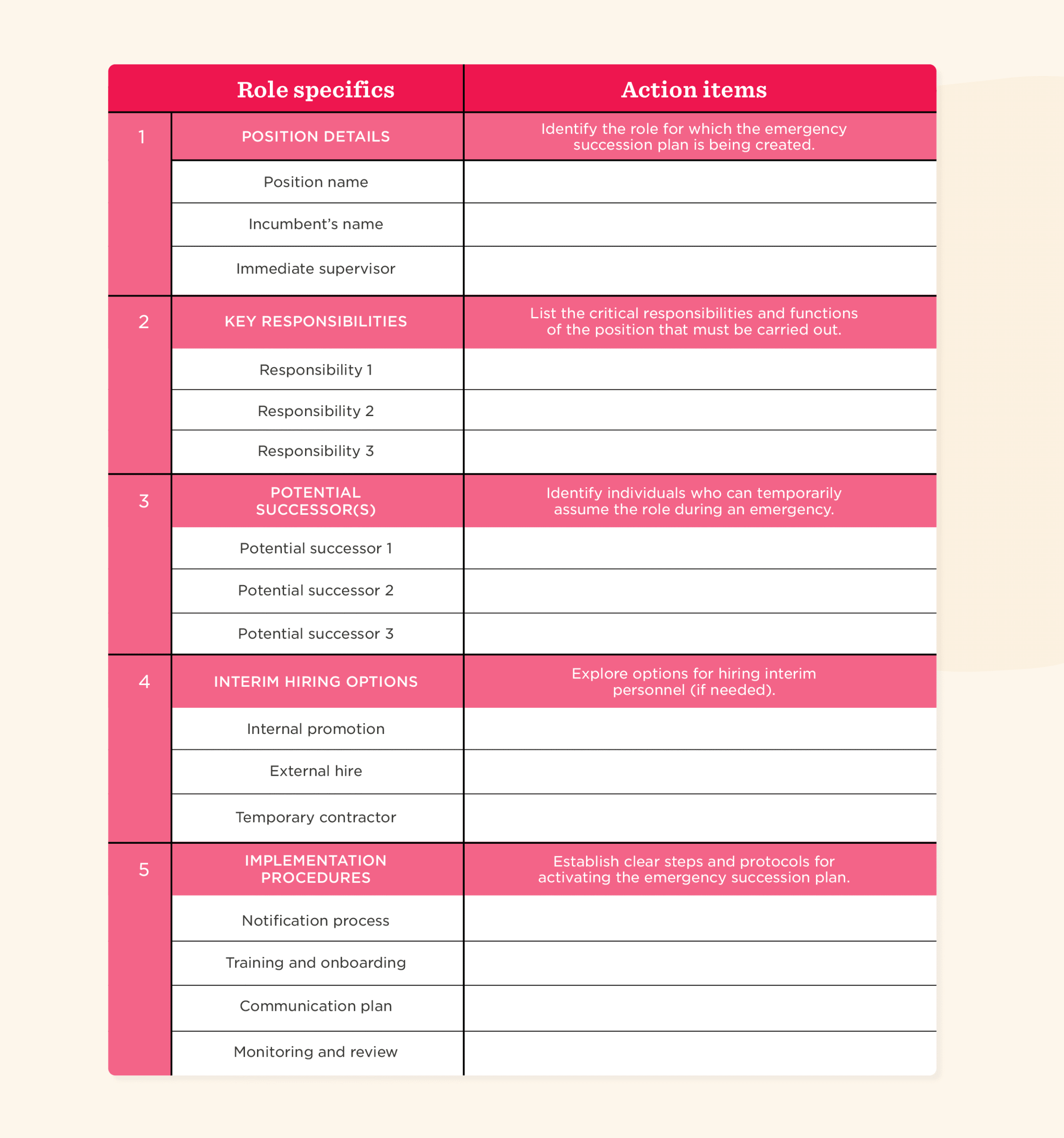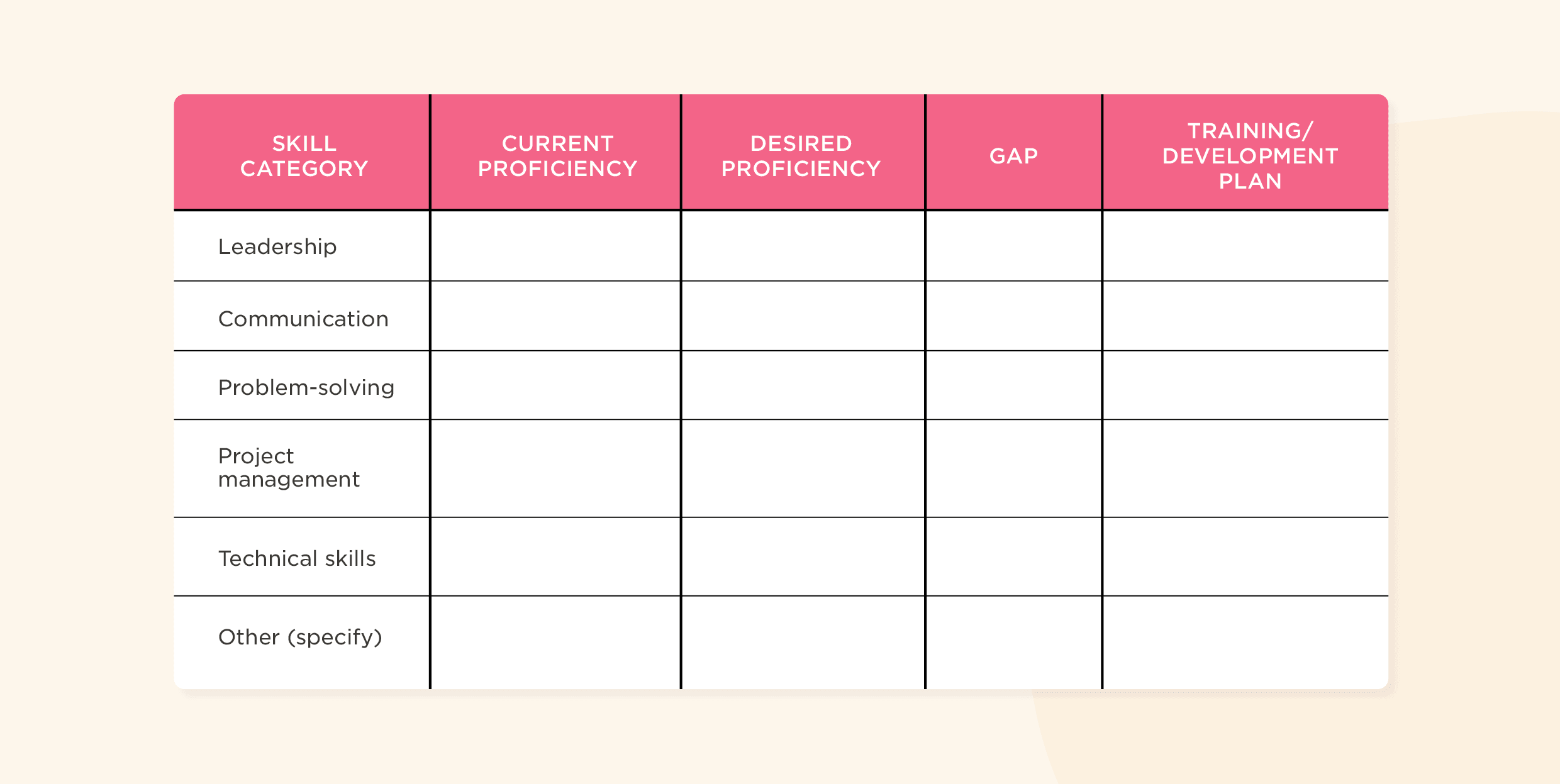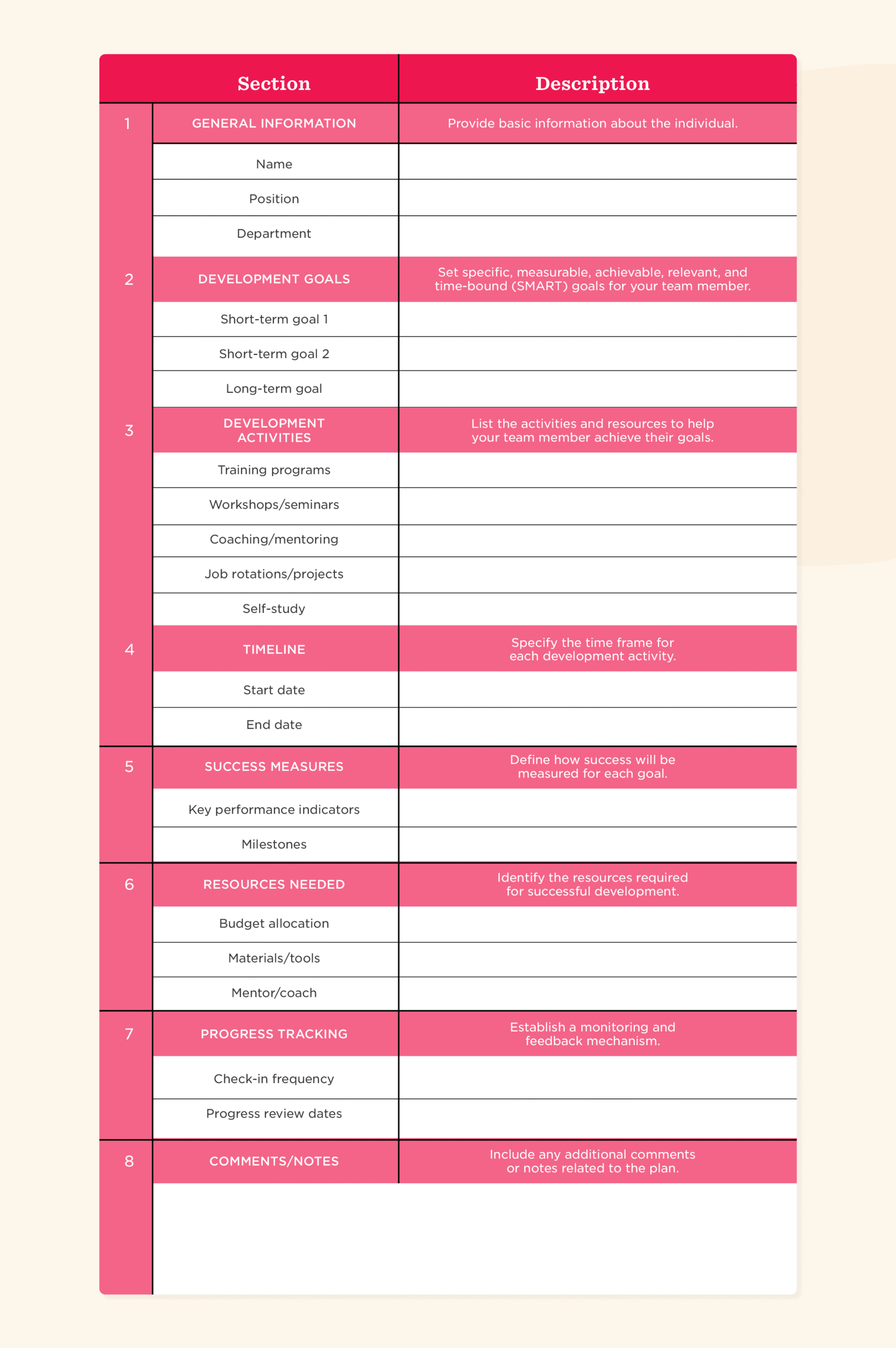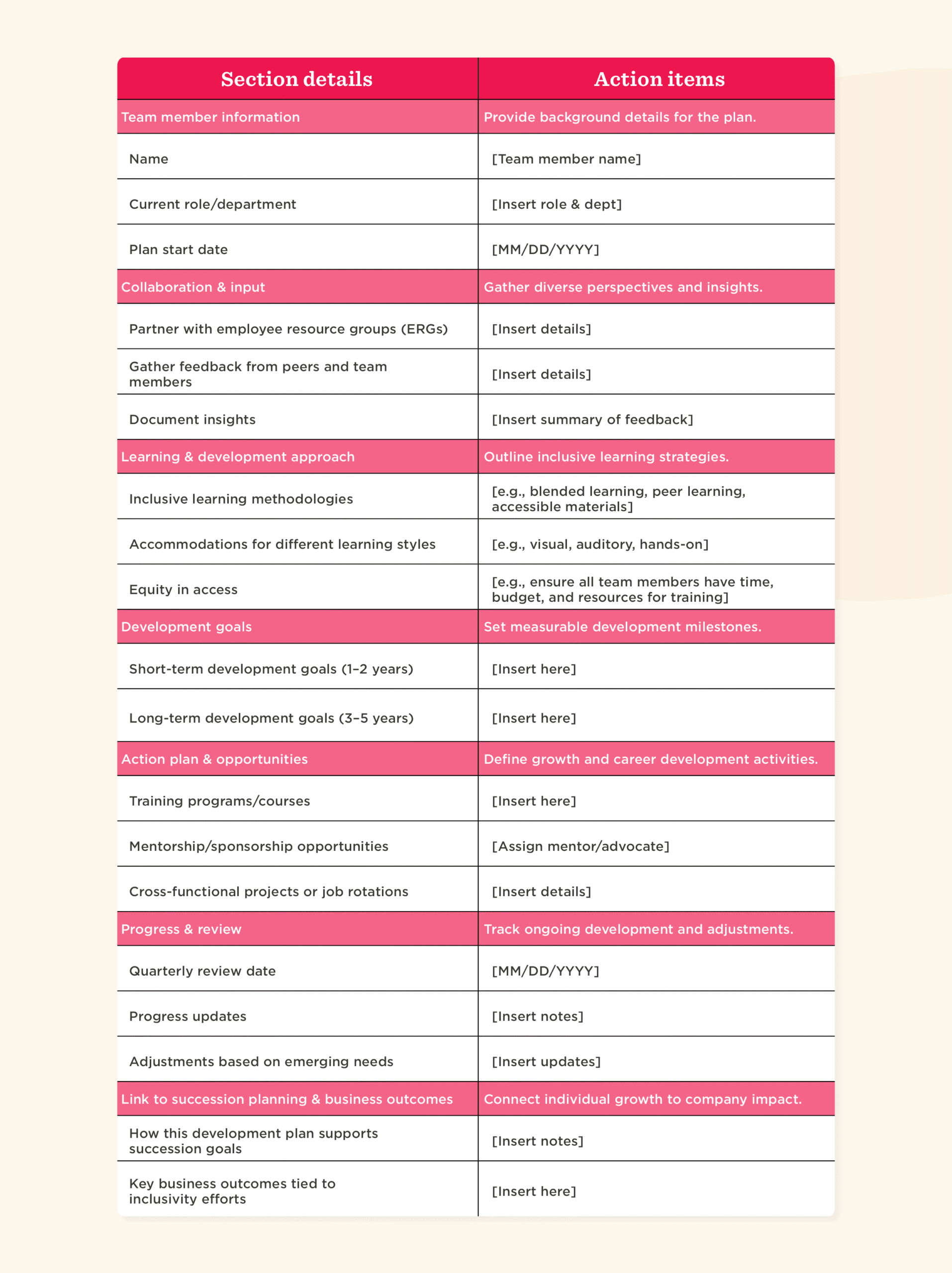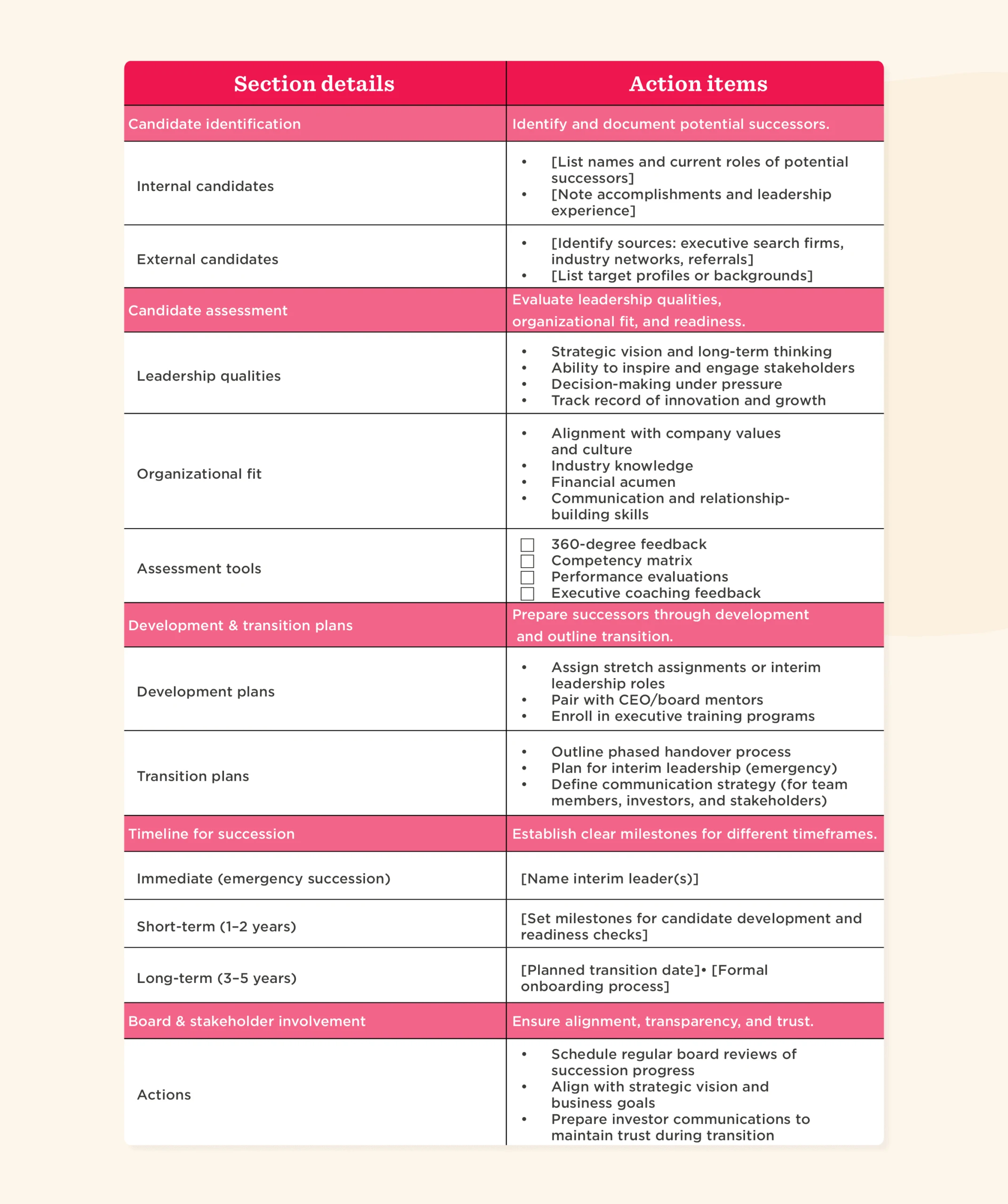Change isn’t just part of business—it drives it. As teams grow, shift, and adapt, strong leadership pipelines keep things moving forward. That’s where succession planning comes into play. More than an HR process, it’s a strategy that protects your business and empowers your people.
Using a succession planning template, you can create a comprehensive and proactive succession plan to avoid unplanned downtime and boost morale. When team members see there’s a smooth plan in place for every big change, they feel more certain about the future of their workplace.
This guide dives into the pivotal role of succession planning in HR with key examples you’re likely to encounter. Plus, you can download all of our free succession planning templates by clicking the links below.
Key insights
- Succession planning templates simplify leadership transitions by offering structured approaches for various scenarios, including CEO succession and emergency planning
- Using tools like skills gap analysis and leadership development plans, you can identify and nurture high-potential talent effectively
- Download these free succession planning templates to support continuous learning and development, and build a resilient and adaptable leadership pipeline
What is succession planning?
Succession planning prepares internal talent to take on critical roles as the organization evolves. This long-term strategy ensures that leadership responsibilities transition smoothly when senior leaders move on.
Ani Huang, president and CEO of the Center On Executive Compensation, explains it this way: “It’s about what’s going to future-proof the organization. The long-term value and sustainability of the company is inherent not just in who you pick, but the process itself.” Succession planning also helps team members understand their career path and trajectory, which can encourage them to develop skills and participate in training.
<< Download free templates to start building your plan. >>
Free succession planning templates
Ready to see how templates work in action? We’ve created a set of free examples you can adapt for your organization, whatever your industry.
Basic succession planning template
This basic template takes a straightforward approach to succession planning. You can adapt it based on your company’s needs.
For instance, you may want an overall executive succession planning template, covering the most executive positions in your business. Or you may want to tailor it for just one position—for example, a CEO succession planning template.
This template provides structure while giving you plenty of room for adaptation.
Emergency succession planning template
As anyone in HR already knows, unexpected changes happen. This emergency succession planning template helps your organization support smooth personnel transitions, especially in the event of an unforeseen leadership change.
Use this template as your foundation to create a strategic blueprint for managing temporary or unanticipated absences of key personnel, such as executive directors or CEOs.
First, identify the main duties your people must carry out, explore contingency measures for interim or alternative hires, and establish clear protocols for the seamless execution of your emergency succession plan.
Customize this flexible template to suit your organization’s specific needs.
Recommended For Further Reading
Skills gap analysis template
A skills gap analysis template compares current competencies with the skills required for key roles. It highlights gaps early so you can design targeted training, mentoring, or development programmes to close them.
If you spot gaps between an individual’s existing skills and the skills they need to succeed in a higher-level position, you can pinpoint what targeted training, learning and development, and mentorship programs they might need to bridge those gaps.
This template helps you to proactively cultivate a pipeline of qualified talent for smooth transitions into leadership and critical roles.
Here’s how you can use a skills gap analysis for prospective candidates during your succession planning with the template below:
- Skill category: List the specific skill categories relevant to the target role or position. We’ve included some examples for you, but you can change these.
- Current proficiency: Assess the individual’s proficiency in each skill category on a scale (e.g., one to five, novice to expert, etc.).
- Desired proficiency: Define the proficiency level required for success in the target role.
- Gap: Calculate the difference between the current and desired proficiency levels.
- Training and development plan: Outline the specific actions, programs, or initiatives recommended to bridge the identified skills gaps.
Employee development plan template
Now that you’ve spotted the skills gaps within the team, develop a plan to help your people achieve their full potential.
Employee development plans play a crucial role in cultivating a thriving and high-performing team. Employee development plans empower people to grow their skills and prepare for leadership opportunities. Tailored training, mentoring, and project experience build a strong pipeline of future leaders and ensure smooth leadership transitions.
Learning and development with an inclusivity focus template
To make succession planning more inclusive, use a learning and development template with DE&I built in. Standardized worksheets reduce bias and create career pathways for people from all backgrounds. You can customize this template by:
- Collaborating with employee resource groups to gain authentic perspectives
- Gathering feedback from team members at various levels and backgrounds
- Incorporating inclusive learning methodologies and employee development practices that accommodate different learning styles
- Scheduling quarterly reviews to assess progress and adjust initiatives based on emerging needs
- Connecting inclusion efforts directly to business outcomes and succession planning goals
Succession planning template for high-potential strong candidate identification
To identify strong candidates, many teams use the 9-box model, also known as the 9-box grid, to visually compare work performance and potential.
You can use the 9-box succession planning template to help you identify leaders and strategically prepare people for future roles. It’s also a valuable tool for managers, particularly those responsible for developing and hiring emerging talent.
Using the information you’ve gathered from the other succession planning templates—like the skills gap analysis template and the employee development plan template—you can use this chart to place the right person in the right position at the right time.
From this chart, anyone in the “high performer, high potential” category is an ideal candidate to take on the role.
You may also include anyone within the “moderate performer, high potential” and “high performer, moderate potential” categories in your shortlist, since these people could also be promising candidates.
Leadership development plan template
A leadership development plan template gives you a consistent framework for identifying and developing leaders. It creates visibility into leadership capabilities, spots high-potential talent early, and ensures development aligns with company values.
This is especially valuable during succession planning since it provides you with the talent analytics needed to map your people to future leadership roles. With a free leadership development template like this one, you can monitor the following information about your future leaders:
- Name and role-related details
- Career goals
- Skill development needed
- Action plan and timeframe
- Stretch assignments to test new skills
- Supervisor feedback
- Progress tracking with regular feedback loops
CEO succession planning template
A CEO succession planning template helps your company prepare for leadership changes and guides the process of identifying, assessing, and developing potential successors for the CEO role. Mapping out the process in advance can help you keep operations running smoothly and maintain investor trust.
This template maps out the CEO succession process from start to finish, ensuring clarity and trust at every stage. This free template includes sections for:
- Identifying potential internal and external candidates
- Assessing leadership qualities and organizational fit
- Outlining development and transition plans
- Establishing a timeline for the succession process
<< Download free templates to put succession planning into action. >>
Succession planning best practices
Succession planning lays the foundation for an organization’s enduring success. You can use these best practices when starting your succession planning to keep your business resilient, agile, and ready for change:
1. Determine upcoming business challenges
“The key to successful succession planning,” as human resources specialist Elke Hofman points out, “is starting early, particularly for large, publicly listed companies, where foresight can span several years.” Anticipating shifts in technology, regulation, or the economy helps you design a strategy that’s resilient, not reactive.
Use scenario planning to explore how different external factors might affect your most critical roles and competencies. For example, a regulatory change could demand new compliance expertise in senior leadership, or emerging technologies might require new technical skills in your IT leadership team. Mapping these possibilities gives you a clear picture of what tomorrow’s leaders will need to succeed.
2. Collaborate with senior leadership
Your leadership team has the clearest view of where the company is headed, which makes them essential partners in succession planning. Involving them ensures your plan aligns with long-term business strategy and reflects the realities of future organizational needs.
Set regular strategy sessions with senior leaders to review succession candidates and their progress. Ask focused questions such as:
- Which roles are essential to achieving our 3–5 year goals?
- What skills or qualities will matter most in tomorrow’s leaders?
- Where do we see the biggest talent gaps emerging?
Documenting these conversations over time provides a roadmap for leadership development and keeps succession planning connected to business outcomes.
3. Identify critical roles and competencies
Not every position needs a formal succession plan. Prioritize the roles that have the greatest impact on business continuity and strategic direction—like C-suite executives, technical specialists, or people leaders who oversee large teams.
When assessing these roles, look beyond the current job descriptions. Consider how the demands of each position may evolve as your business grows. For example, a finance lead today might also need strong digital transformation skills in the near future. Revisiting these role profiles regularly ensures your succession plan keeps pace with business change.
4. Promote a culture of continuous learning and development
A culture of continuous learning is one of the strongest ways to prepare people for leadership opportunities. Formal training programs, cross-functional projects, mentorship, and job rotations give team members exposure to new challenges while building the skills they’ll need to step into senior roles.
Encourage team members to create personalized development plans tied to both their current performance and long-term career aspirations. This not only strengthens your internal pipeline but also boosts engagement by showing people a clear path forward in their careers.
5. Support high-potential employees
Spotting high-potential team members early allows you to invest in their growth with purpose. Look at a mix of indicators: consistent performance, adaptability, alignment with company values, and leadership potential beyond their current role. Jennifer Rozon, president of McLean & Company, suggests using “criteria like leadership competencies and evidence from multiple sources beyond the direct manager. Keep a growth mindset; just as organizations change and evolve, so do people.”
Provide these individuals with stretch assignments, executive shadowing, or leadership development programmes that test their skills and readiness. Track their progress against clear milestones so you can measure their readiness for bigger roles.
6. Keep open lines of communication
Engaging in candid conversations with your people about their career aspirations and growth opportunities is a cornerstone of effective succession planning. When you create an environment where team members feel comfortable discussing their goals, it becomes much easier to spot who might be ready to step into more senior roles and where they may need additional support.
Open dialogue gives you valuable insights into:
- Who shows leadership potential: Look for signals like an interest in strategic decision-making or a track record of guiding peers
- Which roles align with career aspirations: Explore whether team members want to move into people management or pursue specialist leadership paths
- What skills require development: Identify gaps in areas such as financial acumen, presentation skills, or leading cross-functional teams
Plan how to communicate the succession plan to relevant stakeholders, including team members, leaders, and potential successors. Open dialogue will help you gain support from leadership and create a clear plan to motivate team members who might grow into future roles.
7. Use a learning management system
Learning management systems centralize training resources and track progress, offering personalized learning paths that align with succession goals. An effective system provides data-driven insights into skill development, helping identify readiness gaps for core roles.
Look for a learning management system that:
- Integrates with your performance management tools
- Automates competency assessments
- Flags high-potential candidates
- Creates targeted development journeys with measurable milestones
For succession planning specifically, regularly update your chosen platform with relevant content like industry-specific case studies, leadership simulations, and role-specific technical training to keep learning aligned with company needs and emerging leadership requirements. Encourage your people to engage with the LMS regularly through mobile accessibility and microlearning opportunities.
Secure your future with smart succession planning templates
Save time creating templates from scratch—download ours for a ready-to-use starting point.
Remember, a successful succession plan is about more than filling positions—it’s about building a resilient workforce that’s confident and prepared for change. Use our free succession planning templates to take the guesswork out of this strategic initiative and ensure smooth leadership transitions for sustained organizational growth.
<< Download this free succession planning template to stay ahead of your business needs. >>
Succession planning template FAQs
What’s the difference between replacement planning and succession planning?
Replacement planning is a reactive, short-term strategy to fill an unexpected vacancy with a specific backup. It’s a quick fix to ensure continuity. Succession planning, on the other hand, is a proactive, long-term strategy that focuses on developing internal talent over time to step into future leadership roles seamlessly.
What is business succession planning?
Business succession planning is the process of building a roadmap for leadership transitions. It’s about preparing for the inevitable—when senior leaders retire, move on, or leave unexpectedly. A solid business succession plan ensures the baton passes smoothly and keeps your company’s momentum and strategic direction on track.
What’s the difference between talent management and succession planning?
Talent management is the big picture—everything from hiring and developing to retaining and engaging your people to meet overall business goals. It’s a holistic process that covers the entire lifecycle of your team members.
Succession planning is a piece of this puzzle, focusing specifically on preparing your people for future leadership roles. While talent management nurtures every individual’s growth, succession planning zeroes in on leadership continuity and readiness.


